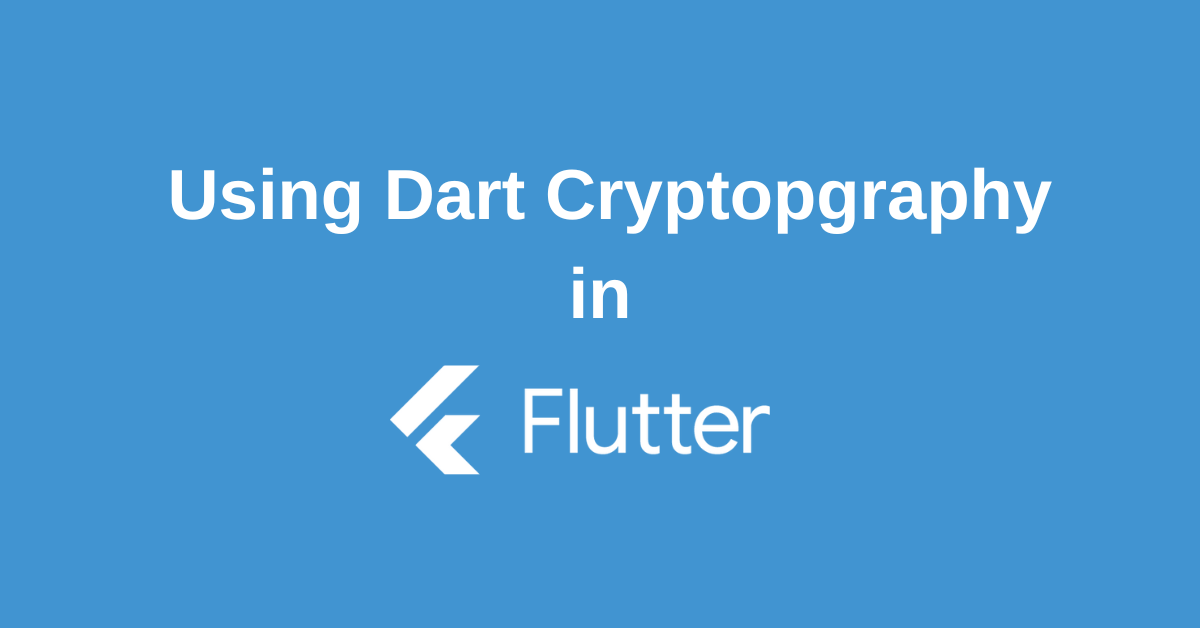In today’s digital age, protecting sensitive user data is paramount for the success and reputation of any mobile application. Flutter, a popular cross-platform framework, provides a robust platform for building secure and scalable applications. However, to ensure the integrity and confidentiality of user data, it’s essential to implement strong cryptographic measures.
This blog post will delve into the world of Dart cryptography, exploring various techniques and algorithms that can be leveraged to safeguard your Flutter apps. We’ll discuss fundamental concepts, best practices, and real-world examples to help you build secure and resilient applications.
Flutter Crypto: A Promising Ladder to Dart Cryptography
Dart Cryptography, a powerful tool for securing Flutter apps, is primarily implemented using the Dart crypto package. As a pure Dart library, it offers developers a straightforward way to integrate various cryptographic algorithms into their applications, boosting security without sacrificing simplicity.
Dart Cryptography is a comprehensive library that simplifies the integration of cryptographic algorithms into Flutter apps. It’s a pure Dart implementation, offering excellent cross-platform compatibility across platforms like Linux, Android, macOS, iOS, and even Flutter Web.
//import statement for package dependency
import 'package:cryptography/cryptography.dart';The package furnishes three kinds of entities: cryptographic keys, algorithms, and services. But the main star of the package is its cryptographic functions.
Digging Deeper into Hash Functions
Dart Cryptography’s hash function is a powerful tool for ensuring data integrity. By converting any input data into a fixed-length output, it creates a unique fingerprint for that data. This process is irreversible, meaning you can use the input to generate the hash, but not the other way around.
Here’s a glimpse of hash computations with Dart:
// Create a hash function (Sha-256 in this case)
final hashAlgorithm = sha256;
// Data to hash
final message = utf8.encode('Hello Dart!');
// Compute Hash
final hash = await hashAlgorithm.hash(
message,
);
print('Hash: $hash');Flutter Cryptography Vs Dart Cryptography
Flutter cryptography and Dart cryptography are often compared, but they serve different purposes. While Flutter cryptography focuses on encryption and decryption, Dart cryptography offers a broader range of cryptographic functions. Its pure Dart implementation ensures cross-platform compatibility and includes advanced features like HMAC, AES, and password-based encryption.
Effective Use of JSON Web Key for Key Management
While managing encryption and decryption keys in Dart, JSON Web Key (JWK) comes in handy. JWKs can hold properties regarding keys (like ‘kty’, ‘use’, ‘kid’, ‘alg’, ‘n’, ‘e’) and make key management more structured and securely designed.
// Example key
final key = JsonWebKey.fromJson({
'kty': 'oct',
'k': 'AyM1SysPpbyDfgZld3umj1qzKObwVMkoqQ-EstJQLr_T-1qS0gZH75aKtMN3Yj0iPS4hcgUuTwjAzZr1Z9CAow',
});Two Way Cryptography: Encryption and Decryption
One of the core features of Dart cryptography is two-way cryptography. Let’s illustrate encryption as an example:
import 'dart:convert';
import 'dart:typed_data';
import 'package:cryptography/cryptography.dart';
void main() async {
final algorithm = AesCbc.with128bits(macAlgorithm: Hmac.sha256());
// Input parameters
final secretKey = await algorithm.newSecretKey();
final nonce = algorithm.newNonce();
final message = utf8.encode('Hello Dart!');
// Encrypt
final secretBox = await algorithm.encrypt(
message,
secretKey: secretKey,
nonce: nonce,
);
print('Encrypted: ${secretBox.cipherText}');
}
In the above example, decryption can be accomplished by using the decrypt() method instead of encrypt(), and using the same key and nonce that were used for encryption.
Generating and Verifying Digital Signatures
Digital signatures are used to verify the authenticity and integrity of data. They involve creating a signature using a private key and then checking the signature using the corresponding public key.
import 'dart:convert';
import 'dart:typed_data';
import 'package:cryptography/cryptography.dart';
void main() async {
final algorithm = Ed25519();
// Generate key pair
final keyPair = await algorithm.newKeyPair();
final message = utf8.encode('Hello Dart!');
// Create digital signature
final signature = await algorithm.sign(
message,
keyPair: keyPair,
);
print('Digital signature created: ${signature.bytes}');
final isSignatureValid = await algorithm.verify(
message,
signature: signature,
publicKey: keyPair.publicKey,
);
print('Is the signature valid: $isSignatureValid');
}Conclusion
By understanding and implementing Dart cryptography, you can significantly enhance the security of your Flutter apps. From hashing and encryption to digital signatures and key management, the tools and techniques available in Dart provide a powerful arsenal for protecting sensitive user data.
Remember, security is an ongoing process. Stay updated with the latest cryptographic advancements and best practices to ensure your Flutter apps remain resilient against evolving threats. By prioritizing security, you’ll not only protect your users’ privacy but also establish trust and credibility in your application.

